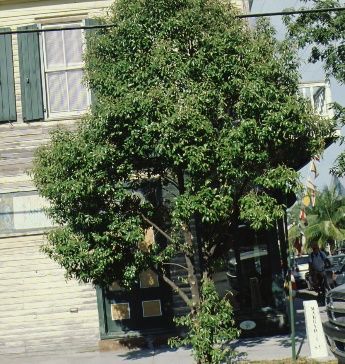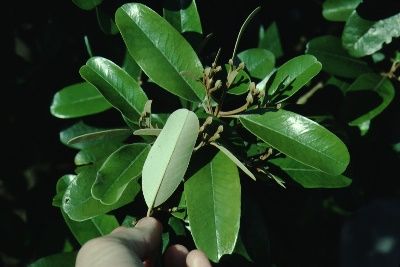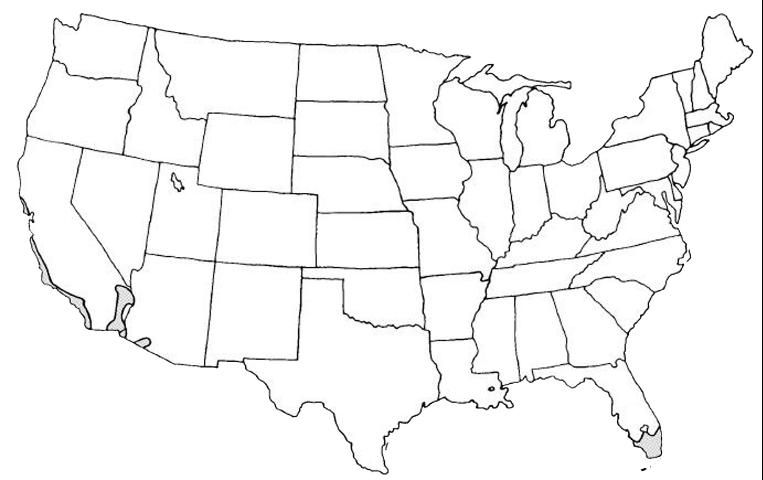Introduction
This 6 to 20 foot-tall, native shrub is an upright to spreading plant that is related to plants producing edible capers. The evergreen leaves of the Jamaica caper are light green above, with fine brown scales below. These glossy, oval leaves are folded together when they first emerge and give the plant's new growth a bronze appearance. The leaves also have a notched tip. Twigs are brownish gray and pubescent. Jamaica caper flowers have very showy, two-inch-long, purple stamens, white anthers, and white petals. The inflorescence is comprised of terminal clusters consisting of 3 to 10 individual flowers. The fruits are 3 to 8 inch long cylindrical pods containing small brown seeds that are embedded in a scarlet pulp.

Credit: Edward F. Gilman, UF/IFAS

Credit: Edward F. Gilman, UF/IFAS
General Information
Scientific name: Capparis cynophallophora
Pronunciation: KAP-ar-riss sin-oh-fal-oh-FOR-uh
Common name(s): Jamaican caper
Family: Capparidaceae
Plant type: tree
USDA hardiness zones: 10 through 11 (Figure 3)
Planting month for zone 10 and 11: year round
Origin: native to Florida
Invasive potential: not known to be invasive
Uses: near a deck or patio; screen; border; attracts butterflies; recommended for buffer strips around parking lots or for median strip plantings in the highway; small parking lot islands (< 100 square feet in size); medium-sized parking lot islands (100-200 square feet in size); large parking lot islands (> 200 square feet in size)
Availability: generally available in many areas within its hardiness range

Credit: undefined
Description
Height: 6 to 15 feet
Spread: 8 to 12 feet
Plant habit: vase shape
Plant density: dense
Growth rate: slow
Texture: medium
Foliage
Leaf arrangement: alternate
Leaf type: simple
Leaf margin: entire
Leaf shape: obovate
Leaf venation: pinnate
Leaf type and persistence: evergreen
Leaf blade length: 2 to 4 inches
Leaf color: green
Fall color: no fall color change
Fall characteristic: not showy
Flower
Flower color: white
Flower characteristic: spring flowering
Fruit
Fruit shape: pod or pod-like
Fruit length: 3 to 6 inches
Fruit cover: dry or hard
Fruit color: unknown
Fruit characteristic: inconspicuous and not showy
Trunk and Branches
Trunk/bark/branches: typically multi-trunked or clumping stems; not particularly showy
Current year stem/twig color: brown
Current year stem/twig thickness: medium
Culture
Light requirement: plant grows in part shade/part sun
Soil tolerances: acidic; slightly alkaline; sand; loam; clay
Drought tolerance: high
Soil salt tolerances: unknown
Plant spacing: 36 to 60 inches
Other
Roots: usually not a problem
Winter interest: no special winter interest
Outstanding plant: not particularly outstanding
Pest resistance: no serious pests are normally seen on the plant
Use and Management
Jamaica caper can be utilized as an understory tree in the partial shade. Train the plant into a tree by removing low, drooping branches, and heading upright branches to thicken their diameter. It can also be clipped into a hedge or tall screen to block an undesirable view.
Grow Capparis cynophallophora in an area that receives full sun to medium shade. This plant performs well in soils with good drainage and can tolerate cold temperatures to 28°F. It is also drought resistant and responds to fertilizer with vigorous growth.
Propagate the Jamaica caper by seeds.
Pests and Diseases
No pests or diseases are of major concern.